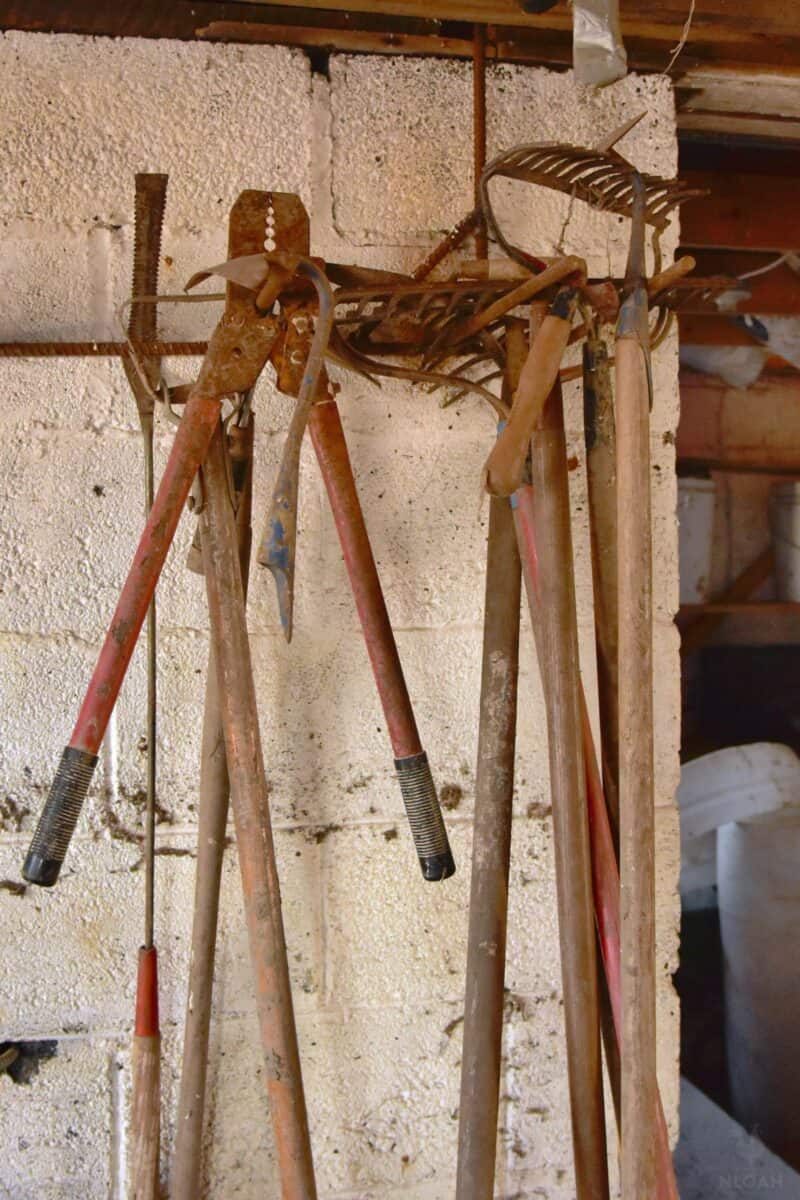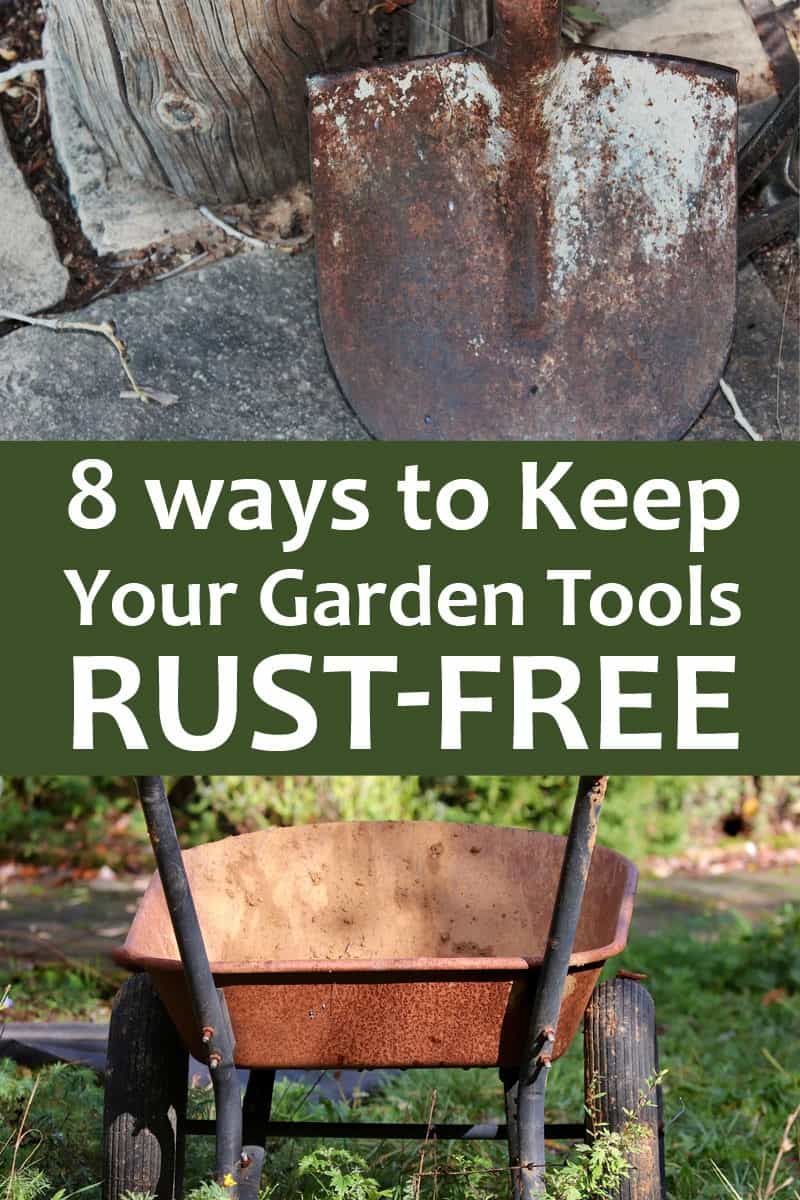It happens to the best of us. We spend hours in the garden, hoeing, clipping, thinning, weeding, pruning…and inevitably, at the end of our day, in our exhaustion, we leave a tool (or two, or three) out in the rain.

Not all is lost! While rusty garden tools can be a nuisance to work with – and could even break when you try to do so – there are easy ways to get the rust off your tools so that you can continue using them long into the future.
The best way to ensure that your garden tools remain rust-free is, of course, not to do this. However, that’s definitely easier said than done! Here are some tips on helping your tools last a bit longer – even if you’ve made a few mistakes along the way.
To help your garden tools last longer, you should follow this advice.
Store Them Properly
Whatever you do, don’t leave them out in the rain, snow, fog…whatever the elements might be. Instead, store them in a dry place inside that offers some protection.
Try to keep them off the ground when not in use, too – like hanging up somewhere. Before you put your tools into storage, make sure you give them a good wash and dry, too. This is especially important if you used your equipment on plants that produce a heavy sap, like trees.
You may need to soak your gear in hot water or use a product like Pine-Sol or WD-40 to get off the gunk.
Otherwise, wiping your garden tools down with a damp rag (and then drying them!) should do the trick. If you’re putting tools away at the end of the season, be sure to sanitize them.
This can get rid of any pathogens and fungi that are on your plants so that you don’t transfer them to new growth in the spring.
To sanitize your garden tools, simply combine one part bleach with ten parts water. Rinse each tool in the water, then dry each piece off again.
Buy High Quality Tools to Start With
The best possible thing you can do to prevent rust on your tools is to purchase those that are less likely to rust in the first place.
Stainless steel is much less likely to rust than other materials, but it’s not foolproof. When not cared for properly, stainless steel can still corrode or rust just like other materials.
Use the Brush Attachment on Your Drill
If you have a rusty tool, it’s not necessarily the kiss of death you think it is. In fact, lots of people are so discouraged by rusty tools that they throw them right in the trash – but this is a mistake.
Even if you do the best you can to keep your tools free from rust, it happens. Luckily, there are ways you can salvage your tools without throwing them out.
One of the easiest ways is to use the wire brush attachment on your drill. Be sure to wear eye protection when you’re working, as this tool is known to throw off tiny pieces of wire.
Sand and Sharpen Your Tools
If you’re working with tools that have wooden handles, one of the easiest ways to get rid of splinters and smooth out the rough grain is to simply sand them. Often, the grain becomes damaged when wood gets wet.
When you’re using other types of tools, like clippers, spades, shovels, pruning shears, or pitchforks, you’ll want to make sure you keep all of the blades sharp.
This will make your life a lot easier. Not only will you not have to work as hard when you’re using the tool, but a sharp edge will keep plants healthier, too.
To sharpen your garden tools, you’ll just need to use a mill file (or a flat metal file). Use the bevel on the tool blade to guide you, placing an end of the file on the bevel.
Push the file, applying light pressure away from your body but against the bevel. After every stroke, you’ll need to move the file to the next spot.
After you’ve sharpened the tool, you can use some sandpaper to remove any burrs that might be on the blade.
If you are trying to sharpen a smaller tool, like a pair of shears, you may need a keener edge to get the job done. A small diamond stone can work wonders and the process is more or less the same as if you were to use a file.
Make a Sand and Mineral Oil Rub
Store a bucket of sand sprinkled with plenty of mineral oil next to your tools. After you use your tool, rub it with the sand to clean the dirt off. The oil will leave a protective coat that prevents rusting, keeping your tool as good as new! Wipe any excess oil off with a rag.
One a year, lightly sand any wooden handles, and rub with linseed or mineral oil.
Use White Vinegar and Steel Wool to Clean Your Tools
Remove any rust by scouring with steel wool, or soaking the tool in white vinegar. Vinegar is seriously a miracle cleaner. As long as you have some time to kill, it will work wonders at removing all the gunk, rust, and dirt that is built up on your gardening tools.
Vinegar is so effective because it contains acetic acid. When acetic acid meets rust, the two react to form iron acetate, which is a water-soluble compound that can easily be rinsed off. Using vinegar doesn’t just clean the metal on your gardening tools – it removes existing rust, too.
What I like to do is fill a jar or bowl with white vinegar and then put the tools inside. Leave them there for at least 24 hours – this will give the acidity in the vinegar time to really work its magic.
After about 24 hours, the vinegar should have begun to work its magic. You can then use a rag or, if the rust is really stuck on, you can use some steel wool and go to town, too.
For some tools, a scouring pad might work best. This will let you get into all the nooks and crannies of your gardening tools. If you’re working with complicated tools, like pruning shears, that kind of flexibility is essential.
Make Sure You Dry Them Off
When you’re done cleaning your tools, don’t simply let them sit in the water! You need to dry them off. Make sure you get the tool as dry as you can because leaving any water on the metal can lead to additional rust.
Lubricating your gardening tools is a good idea, too. Use a rust-protecting oil that will lubricate and guard the tool against future damage for best results. Some people use olive oil, but you need to be careful about doing this as over time, olive oil can turn rancid. You may want to invest in a three-in-one cleaner, lubricant, and protectant all in one instead.
When in Doubt, Try Turpentine
To remove stuck on sap, use Turpentine. It can be used for any items that might be covered in sap and is incredibly powerful – you won’t have to wait long for it to do its work.
Anyone know of any other good tips for keeping your garden tools in tip-top shape?

updated 06/05/2020 by Rebekah Pierce

A city girl learning to homestead on an acre of land in the country. Wife and homeschooling mother of four. Enjoying life, and everything that has to do with self sufficient living.

Tool ar made in lots of different metals – stainless steel, aluminum, carbon steel – and more.
Is Turpentine and the other products you mention not to be use on any specific material.
Also – if Tool has handles made of wood, plastic or another material – do you need to be be carful not to let these cleaners get on these surfaces?
Thanks
I have heard that if you spray your tools with pam or cooking spray it keeps the dirt from building up and provides some protection from rust. Justas with construction tools though, *never* ‘wash’ your tools, always use something (like the sand you suggested) to clean it off and leave your tools dry. Washing them will make them rust for sure.